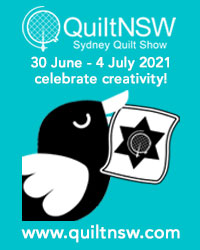Materials List
- A hand-dyed wool top. This is Colour 8 dyed by Martien van Zullen and I got it from The Thread Studio
- Some weird yarns in sort of complimentary colours to the wool top. These are from the box I've filled with balls from Lincraft or Spotlight or some $2 shop
- Copper metallic DMC thread
- A quilt sandwich with white homespun for the top and bottom and two layers of acrylic/wool felt as the wadding. Don't pin it or spray it or anything. I just pressed the fabric and the felt and made the sandwich. The bottom should be about three inches bigger on all sides than the top. Makes it easier to machine quilt the corners and edges later on. I didn't do that this time but should have
- Solvy, a thin, transparent water-soluble film, enough to cover the quilt top
- Couple of different variegated threads for machine quilting
 The purple yarn is an acrylic eyelash and the other two are called pom-poms. They are actually two different yarns twisted together. They are pretty versatile as you can use them as-is or untwist them and use the two yarns separately.
The purple yarn is an acrylic eyelash and the other two are called pom-poms. They are actually two different yarns twisted together. They are pretty versatile as you can use them as-is or untwist them and use the two yarns separately. The Process
The ProcessI wish I could take credit for the process I followed but I learned how to do this in Gillian Hand's Faux Felt workshop organised by ATASDA.
I've been reading the book Color and Composition for the Creative Quilter so decided to use one of the design principles from that book and make an asymmetrical design of 2/3 to 1/3 in a landscape format. This is a pretty radical step for me because I usually just start and see where I end up and say "Oh, that's an asymmetrical design of 2/3 to 1/3 in a landscape format. Well, what do you know!"
Step 1: Laying Down the Wool Fibres
I started by laying the wool fibres on the quilt top. This layer needs to be thick enough so that you can't see the fabric underneath. Anything more than that and you are just wasting your wool fibres.
Purple fibres were put on the left 2/3rds; orange fibres on the right 1/3rd of the quilt top. Fibres that moved from purple to orange went in the middle. Some darker purple fibres were added to the left 1/3rd and I got this:
 A close up shot so you can see just how puffy this layer is.
A close up shot so you can see just how puffy this layer is. I decided it was a bit tame so added some higher contrast bits from the wool top and was happier with this:
I decided it was a bit tame so added some higher contrast bits from the wool top and was happier with this: Step 2: Adding the Threads
Step 2: Adding the ThreadsI made a conscious design decision not to use silk tops in the piece so for some bling, I added the metallic DMC thread. I find that the copper suits most of the work I do, but I still have lots of other colours, just in case.
I wind my DMC thread on those plastic or cardboard spools ... it adds interesting kinks to the thread. I cut a length off the spool and cut it into shorter lengths.
 Then I separated the 6-strands into single threads and scattered them on the orange 1/3rd of the quilt.
Then I separated the 6-strands into single threads and scattered them on the orange 1/3rd of the quilt.
 Next Post: The Rest of Step 2. Stay tuned.
Next Post: The Rest of Step 2. Stay tuned.






5 comments:
Thanks, M, for sharing this. I enjoy seeing the process of art works, so I know this will be interesting. I love the scrumptious oranges and purples!
Cheers
Looks luscious - can't wait for the next step
I've never game enough to try/do things like this, I am v.interested to see how the finished item will turn out, so will "stay tuned".
Looking very interesting, Maggie - can't wait to see how it turns out! Colours are luscious.
I'd love to be able to do this, thanks for showing how to start, look forward to part2esifuux
Post a Comment